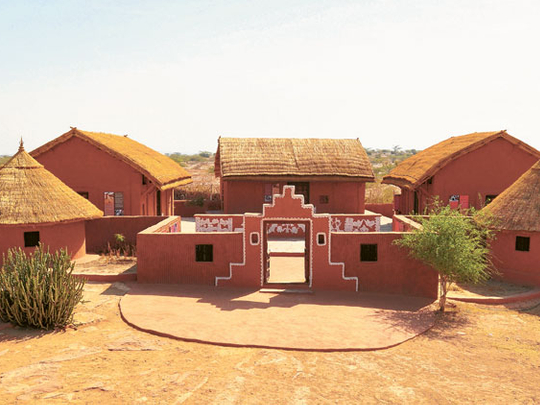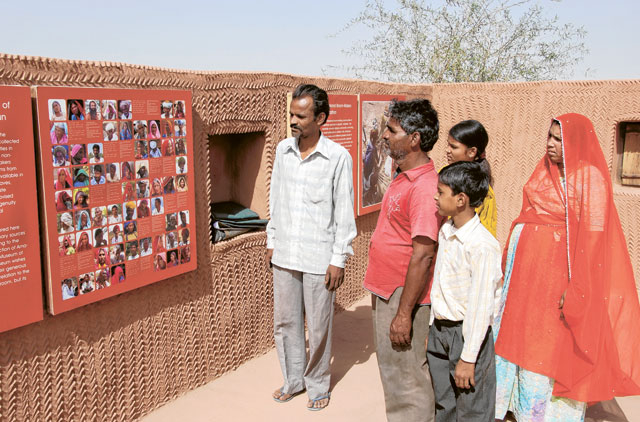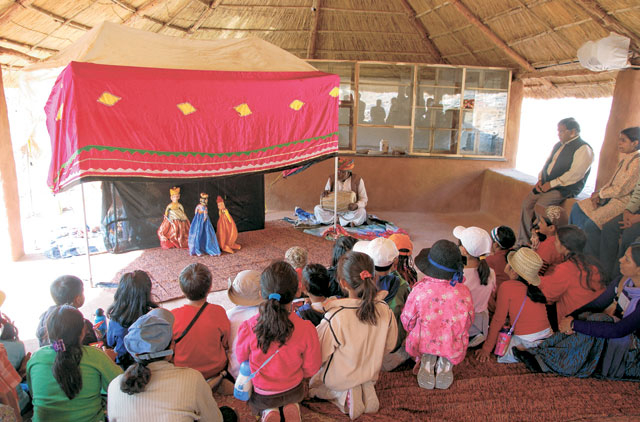
A peacock's distinctive call reverberates through the Arna Jharna Desert Museum, an ethnographic museum located in Moklawas village, Jodhpur, in the northwestern Indian state of Rajasthan. Reinterpreting the conventional notion of a museum, Arna Jharna showcases the diversity of desert life and positions its knowledge systems as the point around which the museum and its vision revolves.
Spread over four hectares of undulating terrain, the museum depicts desert life as a living, dynamic entity through its folk exhibits and artefacts, flora and fauna, and water-conservation efforts. Perceiving itself as an alternative, unconventional educative space, Arna Jharna seeks to redefine the traditional boxed museum experience.
The vision of the late Komal Kothari, an eminent Rajasthani folklorist and oral historian who dedicated his life to acquiring, processing and documenting Rajasthan's traditional knowledge systems, the project is now being continued by his son Kuldeep Kothari.
After the death of Komal Kothari in 2004, Kuldeep translated his father's vision into reality, creating the museum as an additional arm of Rupayan Sansthan, the family's Jodhpur-based folklore research institute.
The site of the museum originally being a disused sandstone mine, Arna Jharna derives its name from a nearby 900-year-old temple and the 600-year-old water body inside it. The latter was also reputed to possess healing properties and is said to have attracted hundreds of thousands of visitors annually.
"We had long been searching for locations [for the museum] and my father instinctively responded to this piece of land," says Kothari of the site. Construction began in March 2003 and Komal Kothari used to regularly visit the site. "He thus became very attached to the place and even conceived a road map as to what to do with it," Kothari says.
The museum's features include an open activity area where workshops or seminars and children's camps are held, and padwas, traditional village hutments, which also provide space for workshops; other padwas are under construction and will showcase puppetry and metal tools.
There is also a Broom Exhibit which opened last year and is of three years' duration. The exhibit displays 160 varieties of brooms used in Rajasthan.
The crater of the mine has been converted into a water body, Vijay-sar, which harvests rainwater and has a capacity of 15 million litres. "We deliberately left the terrain unchanged, and that included ensuring that the indigenous plant species, such as khejri, ker and ber, continue to grow here, in addition to other ethno-medicinal plants," Kothari says. He adds that due to the presence of Vijay-sar, the area has become a natural hub for birds — attracting more than 50 migratory species — and a nesting ground, especially for peacocks. It also acts as a sanctuary for many animals.
It is this respect for the natural world that verily embodies the museum's aim to illuminate the significance of the traditional knowledge systems in Rajasthan. "The core idea of the museum is to explore an ordinary man's mode of survival in nature: How will he survive without basic amenities?" Kothari says. The museum thus addresses the idea of cultivating awareness about one's natural surroundings and working in sync with nature, the desert in this context, constantly learning from it and accumulating a knowledge base. "The means of survival will be different from area to area, as the environment will vary according to where one is," Kuldeep points out, touching upon the notion of local within local knowledge and thus implying the hugely variegated nature of knowledge. "There is destruction of diversity and heterogeneity nowadays. We were earlier self-sufficient, relying on knowledge and the process of creation. But we are only interested in consumption now."
He says that the museum's primary audience is, in fact, the rural community, which constitutes 60 per cent to 70 per cent of India's population. However, as the rural dwellers experience the effects of globalisation and migrate to urban spaces, they face the danger of both losing access to and forgetting this crucial knowledge.
"However, I do not believe that this knowledge will become extinct," Kothari says, employing the metaphor of seeds to elucidate his point. "We possess many seed varieties in the museum seed-bank; yet it is only the villagers who possess special knowledge about them, such as which seeds will germinate only when they have passed through an animal's tract," he says. "They have cultivated this knowledge for generations."
Further extending the metaphor, he says that seeds can germinate even after lying dormant for decades and, similarly, this knowledge is in the rural dwellers' blood and can be revived with the right kind of stimulus and nourishment.
"We have to make them conscious of the vast sea of knowledge that they possess within them," Kothari emphasises, outlining another one of the museum's aims — to empower local communities through their knowledge base.
Arna Jharna functions as an experimental laboratory of sorts, looking into methodologies of studying and documenting traditional knowledge.
"Eschewing the idea of studying Rajasthan through its traditional administrative blocs, my father chose to approach it through its three staple-food zones — pearl millet, sorghum and corn. Each food zone has its own unique culture and knowledge structure," Kothari says, pointing out that in the desert, food greatly permeates one's life, with rituals, fairs, festivals and even weddings held according to times of crop yields. The crops grow at Arna Jharna while cultural artefacts of each food zone are found in the museum's folk exhibits.
Detailing the genesis behind the Broom Exhibit, Kothari says his father had always been interested in the broom, which plays an elemental role in Rajasthan; the exhibit was in consonance with his belief that one should appreciate even the seemingly humble object.
"We are also dedicated to focusing on the artisan/craftsperson, highlighting those who are responsible for the process of creation," Kothari says. "The museum celebrates the invisible and aims to render them visible."
The broom specimens and even the grasses they are abstracted from are displayed in the exhibit. However, the exhibit desists from limiting itself to mere display, and much effort has been put into painting a socio-cultural portrait of the broom.
The exhibit focuses on the inter-relationship of the various kinds of brooms and a variety of contexts, such as natural materials, local broom-making techniques, lives of broom-makers from marginalised groups, myths and beliefs associated with the broom, and the economy of the broom itself. For example, one learns about the destruction of biodiversity and its impact upon the creation of brooms. "A certain grass which grew around Jaisalmer was used to make brooms; however, it no longer grows there, indicating that if a plant is not found to be useful, it is destroyed," Kothari says. "And so the objects created from it will vanish as well."
Villagers themselves find the exhibit a revelatory experience, driving home the point that the broom is a rural object that only they can create — this object is theirs and the culmination of their vision and knowledge.
Schoolchildren also regularly arrive for day visits or camp overnight at the museum. Realising that they come from urban-centric worlds, Kothari is intent on the children learning to appreciate and be more aware of the natural world. There is also special focus upon children between grades 3 and 5. "It is crucial to make them aware of the subject from a young age; it boils down to stoking their curiosity and making them understand that their environment is a world of identities — nothing is nameless and everything has a use and a function," he says of acquainting the children with this invaluable rural knowledge.
Constantly welcoming international scholars and encouraging them to pursue their research interests, Arna Jharna is steadfast in its commitment to collecting, preserving and curating knowledge. "My father was a processor of knowledge and we would like to pay homage to his legacy at Arna Jharna," Kothari says.
Priyanka Sacheti is an independent writer based in Muscat.














